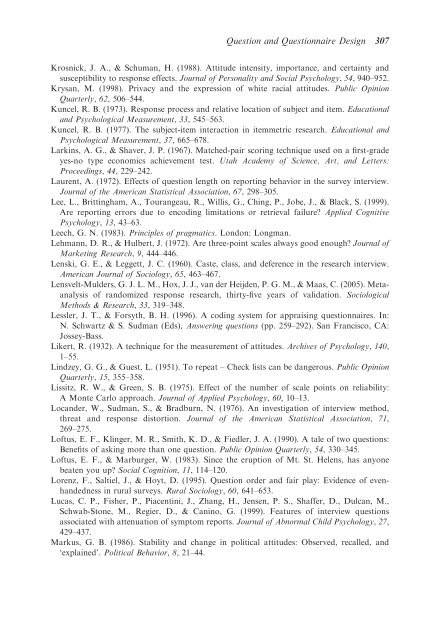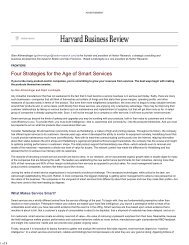Question and Questionnaire Design - Stanford University
Question and Questionnaire Design - Stanford University
Question and Questionnaire Design - Stanford University
Create successful ePaper yourself
Turn your PDF publications into a flip-book with our unique Google optimized e-Paper software.
<strong>Question</strong> <strong>and</strong> <strong>Question</strong>naire <strong>Design</strong> 307Krosnick, J. A., & Schuman, H. (1988). Attitude intensity, importance, <strong>and</strong> certainty <strong>and</strong>susceptibility to response effects. Journal of Personality <strong>and</strong> Social Psychology, 54, 940–952.Krysan, M. (1998). Privacy <strong>and</strong> the expression of white racial attitudes. Public OpinionQuarterly, 62, 506–544.Kuncel, R. B. (1973). Response process <strong>and</strong> relative location of subject <strong>and</strong> item. Educational<strong>and</strong> Psychological Measurement, 33, 545–563.Kuncel, R. B. (1977). The subject-item interaction in itemmetric research. Educational <strong>and</strong>Psychological Measurement, 37, 665–678.Larkins, A. G., & Shaver, J. P. (1967). Matched-pair scoring technique used on a first-gradeyes-no type economics achievement test. Utah Academy of Science, Art, <strong>and</strong> Letters:Proceedings, 44, 229–242.Laurent, A. (1972). Effects of question length on reporting behavior in the survey interview.Journal of the American Statistical Association, 67, 298–305.Lee, L., Brittingham, A., Tourangeau, R., Willis, G., Ching, P., Jobe, J., & Black, S. (1999).Are reporting errors due to encoding limitations or retrieval failure? Applied CognitivePsychology, 13, 43–63.Leech, G. N. (1983). Principles of pragmatics. London: Longman.Lehmann, D. R., & Hulbert, J. (1972). Are three-point scales always good enough? Journal ofMarketing Research, 9, 444–446.Lenski, G. E., & Leggett, J. C. (1960). Caste, class, <strong>and</strong> deference in the research interview.American Journal of Sociology, 65, 463–467.Lensvelt-Mulders, G. J. L. M., Hox, J. J., van der Heijden, P. G. M., & Maas, C. (2005). Metaanalysisof r<strong>and</strong>omized response research, thirty-five years of validation. SociologicalMethods & Research, 33, 319–348.Lessler, J. T., & Forsyth, B. H. (1996). A coding system for appraising questionnaires. In:N. Schwartz & S. Sudman (Eds), Answering questions (pp. 259–292). San Francisco, CA:Jossey-Bass.Likert, R. (1932). A technique for the measurement of attitudes. Archives of Psychology, 140,1–55.Lindzey, G. G., & Guest, L. (1951). To repeat – Check lists can be dangerous. Public OpinionQuarterly, 15, 355–358.Lissitz, R. W., & Green, S. B. (1975). Effect of the number of scale points on reliability:A Monte Carlo approach. Journal of Applied Psychology, 60, 10–13.Loc<strong>and</strong>er, W., Sudman, S., & Bradburn, N. (1976). An investigation of interview method,threat <strong>and</strong> response distortion. Journal of the American Statistical Association, 71,269–275.Loftus, E. F., Klinger, M. R., Smith, K. D., & Fiedler, J. A. (1990). A tale of two questions:Benefits of asking more than one question. Public Opinion Quarterly, 54, 330–345.Loftus, E. F., & Marburger, W. (1983). Since the eruption of Mt. St. Helens, has anyonebeaten you up? Social Cognition, 11, 114–120.Lorenz, F., Saltiel, J., & Hoyt, D. (1995). <strong>Question</strong> order <strong>and</strong> fair play: Evidence of evenh<strong>and</strong>ednessin rural surveys. Rural Sociology, 60, 641–653.Lucas, C. P., Fisher, P., Piacentini, J., Zhang, H., Jensen, P. S., Shaffer, D., Dulcan, M.,Schwab-Stone, M., Regier, D., & Canino, G. (1999). Features of interview questionsassociated with attenuation of symptom reports. Journal of Abnormal Child Psychology, 27,429–437.Markus, G. B. (1986). Stability <strong>and</strong> change in political attitudes: Observed, recalled, <strong>and</strong>‘explained’. Political Behavior, 8, 21–44.
















